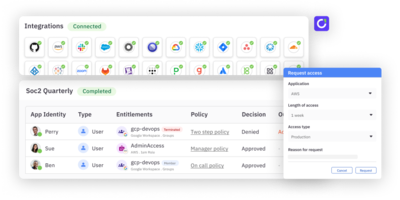Modern evolutions in cybersecurity revolve around two core strategies: the principle of least privilege (PoLP) and the zero trust security model. These are logical, powerful frameworks for protecting critical assets that address different security questions.
The principle of least privilege is focused on authorization and answers the question: “Once authenticated, what is this user permitted to do?” The objective is to grant only the minimum permissions necessary for a specific job function.
Zero trust is a comprehensive strategy focused on authentication and verification, answering the question: “Should this user or device be trusted at this moment?” The objective runs on the philosophy of “never trust, always verify,” requiring continuous validation for every access request.
An effective security posture is not achieved by selecting one security framework over the other. It requires recognizing that least privilege is a foundational principle that is essential to the successful implementation of a true zero trust architecture.
This guide explores the distinct role of each strategy, details the core components that enable them, and demonstrates how they combine to form a unified defense against modern threats.
Key Takeaways
- Zero trust and least privilege are partners, not competitors**.** The central theme is that these two concepts work together. Zero trust focuses on continuously verifying identity, while the principle of least privilege (PolP) focuses on authorization. A successful zero trust strategy requires the enforcement of least privilege.
- Modern security is identity-centric. The traditional “castle-and-moat” security model is obsolete. With the rise of cloud applications and remote work, the network perimeter has dissolved. Identity is now the primary security perimeter, and these modern frameworks are designed to protect it.
- Automation is essential. Manually managing least privilege or zero trust principles at scale is not feasible. Success depends on automating the user access lifecycle, access reviews, and implementing modern methods like just-in-time (JIT) access to grant temporary permissions.
- The goal is a drastically reduced attack surface**.** By combining these strategies, organizations can significantly reduce the number of potential entry points for attackers. This approach contains threats by preventing lateral movement and hardens defenses against both insider threats and external attacks, directly lowering the risk of data breaches.
The Evolution from Perimeter Security
For decades, cybersecurity followed the “castle-and-moat” model, focusing on building a strong perimeter with firewalls and VPNs to protect the internal corporate network. This approach operated on a simple but powerful assumption: anything inside the network was trusted, and anything outside was not.
This traditional model became obsolete when the perimeter itself dissolved. Two major shifts were responsible:
- The move to the cloud meant that critical applications and data were no longer hosted on-premises.
- The rise of a remote workforce and bring-your-own-device (BYOD) policies meant that users were accessing these resources from untrusted networks and personal devices.
The network location ceased to be a reliable indicator of trust, and a new understanding emerged: identity is the new perimeter.
With the perimeter no longer a meaningful defense, attackers shifted their focus to compromising legitimate user identities to get inside. This exposed a core flaw of the old model: implicit trust. Once inside, attackers could move freely throughout the network (lateral movement), and defenses were ill-equipped to handle insider threats.
The failure of the castle-and-moat approach against the modern threat landscape created the urgent need for a new strategy, leading directly to the development of zero trust and the principle of least privilege.
What is the principle of least privilege (PolP)?
The principle of least privilege (PolP) is an information security model focused on restricting the number of identities with privileged access to networks, applications, data, programs, and processes to only those who require that access, and nothing more. In identity and access management (IAM), least privilege is applied by determining the minimal access privileges required for every identity and using access controls to manage that access. Privilege is attached to human users as well as non-human identities and is most often assigned based on the user’s job duties or the non-human identity’s role within an application. This stands in contrast to broader models like role-based access control (RBAC), where a user might inherit permissions they don’t strictly need.
However, too often access to privileged accounts isn’t revoked after it’s no longer needed (e.g., a user changes jobs or the function of the non-human identity is completed) or access privileges are assigned to too many users. This opens up opportunities for unauthorized users to gain access to critical systems or data through human error, vulnerabilities, or misuse.
In practice, applying this principle means moving away from broad, permissive access rights and instead meticulously defining what each identity needs to access. This is especially critical for privileged accounts (like administrator accounts), where excessive permissions pose a significant risk.
The primary goal of PoLP is to dramatically reduce the organization’s attack surface. If an account is ever compromised by an attacker or misused by an insider threat, the potential damage is severely contained because the account’s permissions are, by design, extremely limited. It is a critical, proactive security control and a fundamental building block for a modern security strategy.
Benefits of least privilege
Using the principle of least privilege lowers your organization’s risk level in the following ways:
- Decreases the threat of data breaches and cyber threats by hackers
- Helps the organization meet federal and industry compliance regulations
- Reduces the attack surface area, decreasing the risk of cyber attacks and malware spread
- Allows the organization to track user access and behavior
- Decreases the risks of human error
- Improves overall cybersecurity
Best practices for implementing least privilege
- Identify user roles and access needs: Clearly define the minimum permissions required for each user role.
- Use role-based access controls (RBAC): Implement RBAC to simplify access management and ensure employees have the minimum level of access needed to carry out their job functions.
- Run frequent user access reviews: Regularly review and update user access rights to ensure they remain aligned with job functions.
- Implement just-In-time (JIT) access: Leveraging time-based access controls like JIT allows organizations to grant and revoke access in real time.
What is zero trust?
Zero trust is a security approach that requires everything to be verified. Nothing—no user, no device, no application—is trusted by default. It’s built on the core principle: trust is never implicit.
“Zero trust assumes there is no implicit trust granted to assets or user accounts based solely on their physical or network location (i.e., local area networks versus the internet) or based on asset ownership (enterprise or personally owned),” according toNIST. “Zero trust is a response to enterprise network trends that include remote users, bring your own device (BYOD), and cloud-based assets that are not located within an enterprise-owned network boundary. Zero trust focuses on protecting resources (assets, services, workflows, network accounts, etc.), not network segments, as the network location is no longer seen as the prime component to the security posture of the resource.”
The framework was first introduced in 2010 by John Kindervag, who was a principal analyst at Forrester. Kindervag created the zero trust concept to address a problem he noticed as organizations migrated to the cloud: too many unchecked users with access to accounts, leading to an increased risk of data breaches.
In practice, zero trust means that every access request must be strictly authenticated iand authorized. This verification is continuous, re-evaluating trust each time a user or device attempts to access a resource. To implement zero trust, organizations typically follow key steps: defining the protect surface, mapping transaction flows, architecting the environment, creating policies, and continuously monitoring the environment.
Within a zero trust architecture, all user identities must go through a strict authentication and authorization deployment model that Kindervag set up. Those deployment steps include:
- Defining your protect surface
- Mapping the transaction flows
- Architecting the environment
- Creating a zero trust policy
- Monitoring and maintaining the environment
Benefits of zero trust
Using a zero trust architecture lowers your organization’s risk level in the following ways:
- A detailed process of authorizing user credentials
- Better visibility into overall user behavior
- Less opportunity for a threat actor to move laterally throughout the network infrastructure
- A thorough and accurate inventory of your organization’s IT infrastructure, with complete knowledge of where any and all resources reside
- Better monitoring and alert systems
- Easier creation of security policies
- Better Overall cybersecurity
Key components of a zero trust architecture
- Multi-factor authentication (MFA): Requires additional verification factors beyond a password for access
- Zero trust network access (ZTNA): Provides secure remote access without placing users directly on the network
- Microsegmentation: Divides the network into smaller zones, limiting lateral movement of attackers within the network
Comparing zero trust and the least privilege principle
While zero trust and the principle of least privilege are deeply interconnected, comparing them directly clarifies the distinct and vital role each one plays in a modern security architecture.
At a high level, both frameworks share the same fundamental goal: to secure sensitive data and minimize the risk of cyberattacks by moving beyond outdated, perimeter-based security models.
They both operate on the premise that implicit trust is a dangerous vulnerability. To achieve their goals, they rely on the same core technological pillars, and the ultimate outcome for both is to ensure that only authorized users can access resources, drastically reducing the risk of unauthorized access and security breaches.
However, although they share objectives, they differ significantly in their scope and focus.
- Strategy vs. principle. The most important distinction is that zero trust is a broad, strategic framework that redefines an organization’s entire approach to security. The principle of least privilege is a more specific, foundational principle that is applied within the zero trust framework.
- Verification vs. authorization. They also focus on answering two different, sequential questions:
- Zero trust focuses on identity verification, answering the question: “Are you truly who you claim to be, and should you even be making this request right now?” Its primary function is to authenticate and verify the identity of the user and the posture of the device at every single access attempt.
- The principle of least privilege focuses on authorization, answering the question: “Now that we have verified you, what are you actually permitted to do?” Its primary function is to limit access scope, ensuring that even legitimate, verified users can only interact with the absolute minimum resources required for their job.
Benefits of an integrated approach
By integrating the “never trust, always verify” strategy of zero trust with the granular permissions of the principle of least privilege, organizations achieve a security posture that is far more resilient and adaptive. The benefits extend beyond simple threat prevention, impacting compliance, visibility, and overall operational security.
- Reduces the attack surface and contains threats: This unified approach ensures every user and device has the absolute minimum access required, drastically reducing the number of exploitable entry points. If a breach does occur, strict permissions and microsegmentation contain the threat, preventing the lateral movement of malware and minimizing potential damage.
- Strengthens defense against data breaches: An integrated strategy directly mitigates the root causes of data breaches by neutralizing stolen credentials through continuous verification and limiting the potential damage from insider threats by ensuring an employee’s access is strictly confined to their job function.
- Streamlines regulatory compliance: It provides concrete proof of control over sensitive information that regulations like GDPR and HIPAA require. The detailed audit logs of every access decision allow organizations to easily demonstrate to auditors that their data protection policies are being strictly and consistently enforced.
- Provides comprehensive visibility and control: The combination of continuous verification and granular permissions gives security teams real-time visibility into all access events. This deep contextual awareness allows for much faster threat detection and gives administrators the fine-grained control needed to dynamically adapt security policies in response to emerging threats.
Challenges of implementing zero trust and least privilege
While the strategic benefits are clear, transitioning to a fully integrated zero trust and least privilege model is a significant undertaking.
Organizations should be prepared to navigate several common challenges that require careful planning, investment, and a shift in organizational culture.
- Technical and organizational complexity: Implementing zero trust is a fundamental shift in security philosophy, not just a technology update. It requires a massive effort to integrate modern controls with legacy systems and rewrite security policies from a default “allow” to a default “deny” stance, demanding significant cross-departmental collaboration.
- Balancing security with user experience: A primary challenge is implementing rigorous “always verify” security without creating excessive friction for employees. Constant, disruptive authentication prompts can harm productivity and tempt users to find insecure workarounds, so security must be made as seamless as possible for legitimate work.
- Resource and management overhead: Manually defining and maintaining granular, least-privilege controls for every user at scale is not sustainable. Without powerful automation tools, IT and security teams can become overwhelmed by the volume of policies to manage,access requests to approve, and security alerts to investigate, requiring a significant investment in modern identity security platforms.
Best practices for implementation
Instead of a single, massive overhaul, organizations should follow a roadmap that builds momentum and addresses risks progressively.
- Start with a phased approach: Do not attempt a “big bang” rollout. Begin by discovering and mapping your most critical assets and data flows, then implement Zero Trust controls in manageable phases, starting with your most sensitive applications or user groups.
- Centralize identity management: Establish a modern IAM orIdentity Provider (IdP) as the single source of truth for all user identities. This system is the non-negotiable engine responsible for handling robust authentication, ideally with multi-factor authentication (MFA), for every access request.
- Automate the entire access lifecycle. Manually managing least privilege at scale is impossible. Use automation to manage the full “Joiner-Mover-Leaver” (JML) lifecycle and to conduct regularuser access reviews, which are essential for preventing privilege creep and reducing management overhead.
- Always verify first, then apply least privilege. Enforce the core operational workflow of the integrated strategy. Every request must first pass a Zero Trust verification check of the user and device. Only after being deemed trustworthy should the Principle of Least Privilege be applied to grant the minimum necessary permissions for that session.
Putting theory into practice with ConductorOne
The principles and best practices outlined above provide a clear roadmap for a modern security posture. However, implementing them at scale across a complex environment of cloud apps, infrastructure, and on-premises systems requires a modern identity security solution.
ConductorOne is designed to help organizations move from theory to practice, providing the automation and visibility needed to enforce a true least privilege and zero trust posture.
ConductorOne makes these advanced security strategies achievable with several key uses cases:
- Implements true least privilege with just-in-time (JIT) access. Instead of granting permanent, standing permissions, ConductorOne automates the process of granting temporary, on-demand access to your most sensitive systems. Whether it’s for a developer needing production access or an admin needing elevated rights,JIT access ensures permissions are grantedonly for the time needed and are automatically revoked.
- Automates access reviews to combat privilege creep. To solve the challenge of management overhead, ConductorOne automates the entireuser access review cycle. It periodically and automatically sends review requests to the correct business managers, providing them with rich context and risk insights to make intelligent decisions.
- Provides centralized visibility and control. ConductorOne integrates with hundreds of SaaS applications, IaaS platforms like AWS, and internal databases, creating a single control plane to see and manage all permissions. This comprehensive visibility is essential for understanding your actual security posture, discoveringrisky entitlements, and enforcing consistent security measures across your entire technology stack.
- Prioritizes a seamless user experience. To ensure security doesn’t hinder productivity, ConductorOneintegrates with tools employees already use, like Slack. This allows users to request access and managers to grant approvals directly within their workflow, making the process fast and intuitive. By embedding security into everyday operations, it encourages adoption and prevents users from seeking insecure workarounds.
By automating the core workflows required for a modern security strategy, ConductorOne makes implementing zero trust and least privilege both achievable and sustainable.


